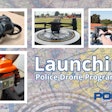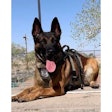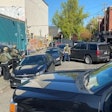On June 30, 1954, Janie Ellis, the wife of a former mental patient, called the police in Indianapolis. She said she needed help right away at her house on Elder Avenue.
Between heavy gasps for breath, she told the dispatcher that she had come home and found her husband, Howard, beating one of their five foster children. When she attempted to stop him, she said he went crazy and tried to kill her with a knife.
In excited tones, she described how she had fought with her husband as he attempted to stab her, and how, after biting him hard enough to make him drop the knife, she had managed to escape out the back door and flee to a neighbor's house. After listening to Ellis' story and finding that Howard was still in the house and possibly holding several of the foster children hostage, the police dispatcher sent two officers to the scene.
Arriving a few minutes later at the neighbor's house, Officers Chris Greenwood and Robert Bates listened to Ellis' story and assured her that everything would be OK. They then walked with her back to her house to speak with her husband. As they approached the house, however, Howard fired a shotgun out the window at them, striking his wife in the leg. The officers, stunned for a moment, grabbed her and raced for cover. While on officer attended to the woman's wounds and the other called police headquarters for more help, Howard began barricading himself inside his house.
Within minutes, dozens of police officers began arriving, but because of the possibility that some of the foster children were hostages, they held their fire, even though Howard shot repeatedly at them. When it was discovered, however, that all of the children had escaped and the gunman was in the house alone, the officers began returning fire. Over the next 2 ½ hours, more than 200 officers responded to the scene and fired more than 10,000 rounds into the rickety, wood- frame house where the former mental patient, armed only with a rifle and shotgun, was holed up. During this period, Howard shot at and hit any officer foolish enough to expose himself.
Although common today, this type of incident was rare in 1954. Consequently, the police had no plan for handling it. No one at the scene, including a number of high- ranking officials who answered the call, seemed to know what to do other than continue to fire at the house. Several times during the standoff, the officers thought they had finally hit the gunman, but more shots came from inside and another officer would fall.
Finally, several officers decided to go in after Howard. Using an armored car as cover, the officers forced their way into the rear of the house where they found the gunman completely untouched by the thousands of rounds. He leaped out from behind a heavy bookcase and fired at the officer, but luckily, he missed. The officers returned fire and hit him with shots from a Thompson submachine gun, a shotgun and a revolver. Refusing to fall, though struck by a dozen bullets, he ducked back behind the bookcase, reloaded his shotgun, and jumped out again. The officers escaped being killed only because his shotgun jammed when he pulled the trigger. The officers fired 26 bullets into Howard, who feel dead to the floor.
The heavy human toll of this incident and the enormous expense in manpower and equipment, sent a message to some people in government that the police department was presently ill- equipped to handle such a high- risk incidents. Requiring 200 officers and over 10,000 rounds of ammunition to neutralize one man demonstrated a significant weakness in police preparedness.
The headline of the Indianapolis Star on July 2, 1954 read: "Big Gun Battle Prompts Plans For Riot Squad." The article told of the city's plans, in the aftermath of the Elder Avenue shoot- out, to form a team of specially trained and equipped officers to deal with situations like this. Board of Public Safety President Paul J. Schick says: "There were too many police at the scene and they were not deployed to the best advantage. Our police force has neither the equipment nor the training to handle effectively such a situation."
However, the special team never materialized. In 1954, events such as the shoot-out on Elder Avenue simply didn't occur often enough to justify the expense of creating and maintaining a special unit. And true to what the critics said of the idea, nothing of this scale occurred again for some time. It would be more than a decade later before a similar incident finally forced America's police departments to recognize their vulnerability and unpreparedness.
[PAGEBREAK]
On Aug. 1, 1966, Charles Joseph Whitman took up a position on the observation deck of the clock tower building at the University of Texas in Austin. He had with him a trunk full of weapons and ammunition. For 90 minutes, from his perch atop the 32-story tower, he randomly shot 46 people, killing 15 of them.
The Austin police in 1966, however, like the Indianapolis police in 1954, had no plan for handling such an incident. So for 90 minutes, they responded to his deadly attack with ineffective gunfire from the ground. Finally, after watching person after person fall from Whitman's bullets, several officers came up with a plan to use a tunnel system that ran under the campus to slip undetected into the clock tower building. Putting this plan into action, four men managed to get into the clock tower building and up to the observation deck unnoticed by Whitman. Once on the observation deck, two officers engaged ina gun battle and killed him.
While the police in Austin eventually succeeded in neutralizing Whitman, the toll he extracted in human lives and suffering, like the toll in Indianapolis, was unacceptably high. For 90 minutes the police did not know what to do and consequently, were unable to stop the slaughter. In addition, the plan that finally did succeed in stopping Whitman was developed on the scene and depended too much on luck. This highly publicized incident finally convinced America's police chiefs that they could no longer depend on seat-of-the-pants planning.
"Special weapons and tactics teams moved into a new era after Charles Whitman climbed into a tower on the first day of August 1966," says Lt. Sid Heal of the Los Angeles County Sheriff's Department in an article in The Tactical Edge. "This marked the birthday of the modern police SWAT (Special Weapons and Tactics) teams concept."
Agreeing in his book, "A Guide to the Development of Special Weapons and Tactics Teams," retired Captain John A. Kolman, who is also of the Los Angeles sheriff's department, says, "Prior to 1966, few, if any, law enforcement agencies staffed specialized teams to deal with armed, barricaded suspects. Generally speaking, these assignments were left to the uniformed patrol officer who may or may not have been prepared or equipped to resolve the matter."
It wasn't the tower sniper incident alone, however, that finally convinced America's police departments that SWAT teams were needed. Other events occuring across the country also had their breath. In 1966, America's inner cities were seething with racial tension and many were poised to explode into mindless violence. In addition, the anitwar movement had recently grown in such numbers and restlessness that America seemed on the verge of plunging into chaos with violence coming from any direction. The incident in Austin was the final impetus America's police chiefs needed. They knew the violence that had wracked other communities could explode in theirs at any moment. They needed to be ready.
They needed SWAT teams.
Early SWAT
One of the first police departments to form a SWAT team, the Los Angeles Police Department, is also believed to be the first police department in the United States to use the acronym SWAT. This unit, formed soon after the Texas tower sniper incident, met with several early successes, including operations against the Black Panthers in 1969 and the Symbionese Liberation Army in 1973. The demonstration of what a specially trained and equipped unit could accomplish, encouraged police departments that had been hesitant, to embrace this new concept and form their own SWAT teams. It didn't take long for these police departments to discover the worth of their investments because they quickly found that the high- profile criminal acts, which had previously been occurring in someone else's community, now suddenly began spreading to theirs.
While previous to the 1960s, events such as the Elder Avenue shoot-out occurred only once a decade or so in a community, the Texas tower sniper incident became a watershed in the history of American crime. Suddenly, any highly publicized crime in one part of the country resulted in copycat crimes in other parts. For example, during the 10 years or so following the 1971 hijacking of Northwest Orient Flight 305 out of Portland, Ore., aircraft hijacking became an almost daily occurrence. Then, once police departments learned how to respond successfully to hijackings and they faded in number, hostage- taking became the high-profile crime of choice, which, in turn, was followed by mass killings at post offices and fast food restaurants, and heavily armed criminals shooting it out with police. All of these high- risk events and their copycat offshoots called for more and more use of SWAT teams.
Growing Need for SWAT
This rapid increase in the number of high- risk crimes naturally had an effect on police SWAT teams. Many of the early teams, formed in the late 1960s and early 1970s, began as small units serving only in an on-call status. These teams carried equipment just a little better than the average street cop carried, and their mission often consisted of simply using brute force to overpower criminal opposition. However, the rapid growth in the number and scope of spectacular and high- risk crimes soon changed this. In the 1980s and 1990s, police SWAT teams began growing in size and many became permanent, full- time units.
"Our team is half again as large today as it was in the 1980s," said Lt. Stephen Robertson, tactical commander for the Indianapolis Police Department SWAT team. "And we've now had to go to full-time status because our call outs have increased so dramatically."
[PAGEBREAK]
Police SWAT teams, when coming up against barricaded and dangerous criminals, also quickly learned that the better the equipment and technology they used, the better the results of their mission. The more intelligence they could gather, and the better their armament, the more likely their chances of success. Successful SWAT teams, therefore, began acquiring not just high- tech automatic weapons with laser sights and sound suppressors, but also the best in high-tech surveillance and intelligence gathering equipment, and the newest in nonlethal weaponry. SWAT teams began acquiring and using devices and equipment such as Laser Bugs that pick up sounds inside a site through a laser beam bounced off of a window, pinhole cameras, flashbangs, rubber impact cartridges, ballistic shields and dozens of other pieces of high- tech equipment.
"The equipment SWAT teams use today is many times more sophisticated than it was when I began in SWAT in the 1970s," Cal Black, former FBI SWAT commander and now security manager for the National Bank of Detroit. "Because of this high- tech equipment, the ability of SWAT teams has increased dramatically."
Along with ever- improving equipment, the evolution of police SWAT teams over the last 30 years has also seen a change in how the teams operate. After a number of early missions, police SWAT teams began learning that, if enough time passed, they could often persuade barricaded criminals and hostages takers to surrender peacefully. The firmest resolve, they discovered, would buckle after enough hours passed, and if presented with an honorable way to surrender, the barricaded criminal or hostage taker would often do so. This led to more and more use of hostage negotiators by SWAT teams.
Police commanders know that hostage negotiators and SWAT tactical officers require individuals with traits and talents that are dramatically different. Hostage negotiators must be able to sit and listen patently for hours, and must have the ability to verbally convince a perpetrator that surrender is in his best interest. Tactical officers, on the other hand, depend on speed, surprise and violence of action to resolve an incident. Because of this difference, in the first years of police SWAT teams, the hostage negotiators were often a unit separate from the SWAT team and called in only when needed. This, however, has changed. Today, in most SWAT teams, the hostage negotiators are an integral part of the team.
Hostage negotiators and tactical officers are now all part of one team because SWAT commanders have found through many incidents that, in order to achieve success, each one needs the other. Hostage negotiators need the tactical officers to contain and stabilize and incident before they can go to work, and the tactical officers need the hostage negotiators to peacefully resolve the incident once they have contained it.
Since their success so often depends on each other, hostage negotiators and tactical SWAT officers are not only part of one team, but today, many times they train together in order for each side to see how the other side works. In this way, they can complement and assist each other.
"By training together, you develop an appreciation of each other's mission," said Indianapolis Deputy Chief Jerry Barker, head of the department's hostage negotiators. "By training together, you also tend to gain a lot of insight into how each other operate," he says.
All of these changes and improvements over the last 30 years have changed police SWAT teams from being the loosely bound units they once were where their primary function was to charge in and forcibly overpower their opposition. Now they are teams of highly trained, well- equipped specialists who have a continuum of choices to use when confronting a high- risk incident. The scene on Elder Avenue, of 200 officers firing thousands of rounds with no plan, has become just a memory. While these types of crimes haven't gone away, the police now have proven and tested plans for handling them. In just a few decades, the dedicated men and women of SWAT have become one of law enforcement's greatest assets.
Robert L. Snow is a 20-year member of the Indianapolis Police Department and is the author of several books, including his latest, "SWAT Teams."











